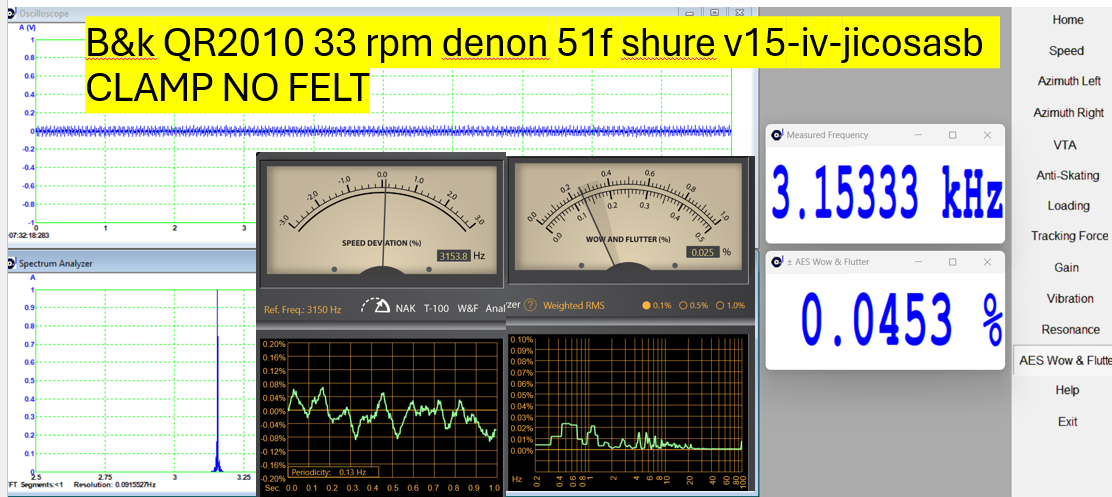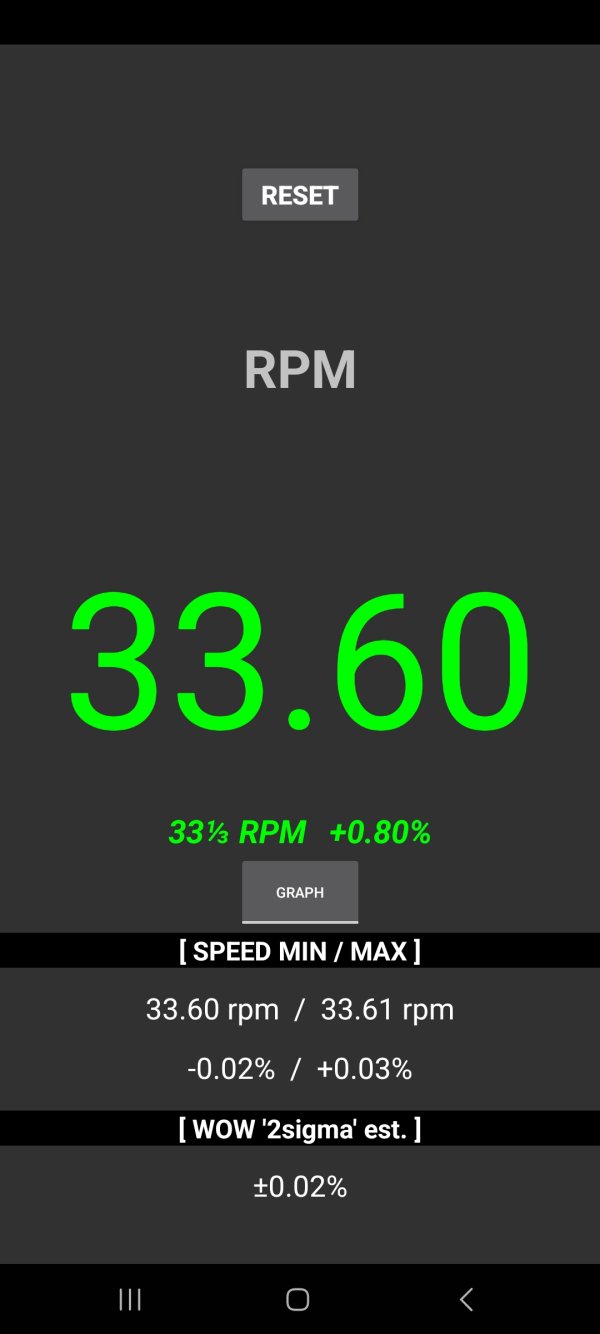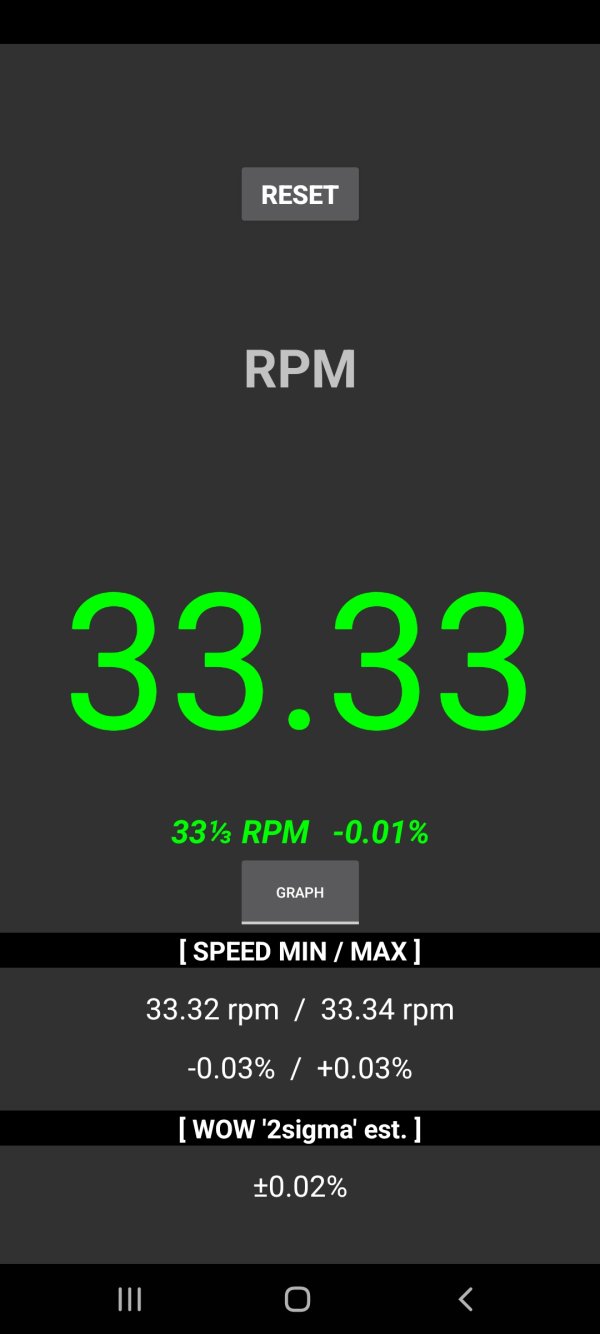Wow&Flutter Measurements Of Turntables And Ways To Improve
- Thread starter mtemur
- Start date
You are using an out of date browser. It may not display this or other websites correctly.
You should upgrade or use an alternative browser.
You should upgrade or use an alternative browser.
It's the meaningfulness of results. At this order; mediocre, poor, uselessWith Shaknspin what’s the difference between DIN, RMS, WRMS?
Please share your wow&flutter measurements of the turntables and the measurement tool here. The most complicated standard is AES and Analog Magik measures in AES. Naturally it yields woorse performance figures compared to others especially instant measuring tools.
Did you calibrate your measurement system with standard calibration files?
Unless people do it the subject is complex enough to make comparisons misleading and erroneous. Proper instant measuring tools, as my Kenwood FL-140 W&F meter, are excellent measuring devices!
AM software uses a test record and software that do not require calibration. In contrast, other phone apps that rely on accelerometers and offer calibration options. On the other hand, the Kenwood FL-140 and similar devices require calibration due to their analog nature. The main issues with these devices are integration time and the measurement standard. Older wow and flutter (w&f) meters, like the Kenwood FL-140, are instant measuring tools with incredibly short or no integration time, and they use lower standards, such as WRMS. Unfortunately, this is not good enough.Did you calibrate your measurement system with standard calibration files?
Unless people do it the subject is complex enough to make comparisons misleading and erroneous. Proper instant measuring tools, as my Kenwood FL-140 W&F meter, are excellent measuring devices!
AM software uses a test record and software that do not require calibration. In contrast, other phone apps that rely on accelerometers and offer calibration options. On the other hand, the Kenwood FL-140 and similar devices require calibration due to their analog nature.
Surely. But calibration with a common wave would establish a reference for other members.
The main issues with these devices are integration time and the measurement standard. Older wow and flutter (w&f) meters, like the Kenwood FL-140, are instant measuring tools with incredibly short or no integration time, and they use lower standards, such as WRMS. Unfortunately, this is not good enough.
We find many conflicting opinions on what is the best measuring system. It is why I referred the need a common standard if people want to compare.
As I said before - I use "instant instruments" for fast control and rely on relative analysis of the 3150 signal spectrum for comparative measurements and optimization. My experience is mainly with tape, not turntables.
BTW, does any one know of a good source of test LPs with the 3150 track that are not too expensive in Europe and having a track lasting for more than five minutes? My test LPs are now well used, as they have short tracks.
How does the 2sigma fit in with these?It's the meaningfulness of results. At this order; mediocre, poor, useless
Good question. I’m not sure but probably it falls among others like WRMS, RMS etc. @Balle Clorin shared a graph comparing those standards. I think it would be great if he shares it here too.How does the 2sigma fit in with these?
0.2% 2Sigma wow can be very different from DIN weighted W&F. .
O.2 DIN is not good and easily audible on piano. A test tone with DIN 0.2 sounds very shaky. I will post a comparison of different WF number formats soon..
Depending on TT and record I get 0.045 to 0.07 with the AM WF calculation

Measures & Glossary
Measures Average speed in RPM.Deviation: Percent deviation of the average vs the correct speed (33.33 or 45).Variation: Maximum and minimum speed observed.Min%, Max%: Maximum and minimum speed obse…shaknspin.wordpress.com
Here are different W&F numbers compared against peak wow in test. This is based on Shaknspin tests, and omits effects of test record eccentricity. I find the DIN values suspiciously low ... but that is what the device gives. AM 30sec calulation will give hiogher numbers since som drift will be detected over 30 sec period.
The plot shows that a DIN W&F of 0.1% actually can have peak wow of 0.25% but it may be filtered out.. of all the turntables measured here(26) the highest filtered DIN W&F is 0.22% and 3 are between 0.1 and 0.2 DIN, the rest below 0.1%DIN. All are belt drive except for one DD
Does anyone wonder why Japanese TT use W&F WRMS for their spec?, it gives the lowest number...
View attachment 142778
This is a very good result, but still audible on a test tone
Above are some examples with Shaknspin data for different turntables. The data from the app can be transferred to Excel, and I massaged the data there for the presentation above.
Below my Denon 51F DD
Shaknspin is very useful , especially if you have a belt drive since they vary more and drift compared to DD,
The plots above is my Denon 51F and it is has better stability than a new Technics 1200GR that Fremer published Shaknspin test on.
Thanks to Shaknspin I was able to get reliable speed data and then I could -by trial and error on leveling and belt tension - reduce wow from 0.2% to 0.05% in my Belt drive Michell Gyro, values for the phone app for you to compare
Note: My Shaknspin absolute speed can be off , 33.42 is 33.33 on strobedisk.
Many of the phone apps do not present DIN or JIS W&F values, just the variation in%. See the Shaknspin documentation for explanations and definitions. Without a reference to the method or standard a simple % value can be very misleading. What I look for is Peak Wow that is close to the 2S value( 95% of the data are less than the 2S value) . This is a good indicator of the speed quality and can be compared directly with most phone apps Wow value. The DIN and JIS (WRMS) values will be lower numbers but can also hide many problems that are obvious in a time plot as given at the top
New Analog Magic V2 records, I returned the first set due to unacceptable warps giving high W&F among other problems.
What seem clear to me is that TT comparisons using anything but the exacts same record is useless. Records from the same vendor are not necessary the same, far from it. One can see relative differences between TT s using the same test record, that is all , but even then the centering must be perfectly adjusted...
If you want to judge W&F across the world, a different method should be used for getting W&F data, for instance ShaknSpin
My Direct drive Denon 51F on V2 33rpm record

On V1 record 33rpm

Same TT on my best 3150Hz record

My belt drive on AM33rpm V2 record

What seem clear to me is that TT comparisons using anything but the exacts same record is useless. Records from the same vendor are not necessary the same, far from it. One can see relative differences between TT s using the same test record, that is all , but even then the centering must be perfectly adjusted...
If you want to judge W&F across the world, a different method should be used for getting W&F data, for instance ShaknSpin
My Direct drive Denon 51F on V2 33rpm record

On V1 record 33rpm

Same TT on my best 3150Hz record

My belt drive on AM33rpm V2 record

Last edited:
@Balle Clorin you've been lucky with the second set of AM V2 discs. Unfortunately my V2 discs are warped and I couldn't have the chance to return them.
My AM V1 disc at 33.3rpm w&f measurement:

This turntable is not equipped with an encoder so the speed can be adjusted using 33.3 rpm knob. I didn't do that cause it's not related with w&f measurement. IME/IMHO any w&f measurement below %0.1 using AM discs is a very good result.
IOT improve w&f following below steps help in my experience:
- Perfect leveling of platter
- Using old belt
- Using old oil or filling bearing completely with oil
- Adjusting the tension of string or belt up to a degree of minor slippage or just before slippage
- Cleaning belt, pulley and platter surface where the belt rides
- Putting belt in talc powder and wiping it with a dry cloth
My AM V1 disc at 33.3rpm w&f measurement:

This turntable is not equipped with an encoder so the speed can be adjusted using 33.3 rpm knob. I didn't do that cause it's not related with w&f measurement. IME/IMHO any w&f measurement below %0.1 using AM discs is a very good result.
IOT improve w&f following below steps help in my experience:
- Perfect leveling of platter
- Using old belt
- Using old oil or filling bearing completely with oil
- Adjusting the tension of string or belt up to a degree of minor slippage or just before slippage
- Cleaning belt, pulley and platter surface where the belt rides
- Putting belt in talc powder and wiping it with a dry cloth
Talc is my secret trick too, old belt with low tension is good too .
With my very suspended TT the platter changes angle when running or not. Running belt creates a drag that shifts the levelling . So levelling perfect when not running does NOT give the best WF data.
This is optimal levelling for me
Last edited:
The problem with my first set of V2 disk was warps that gave W&F on AM software of 0.2 to 0.3% , when my TT is capable of below 0.05%…flat and centred records are usually good enough.ME/IMHO any w&f measurement below %0.1 using AM discs is a very good result.
Luckily my AM vendor is very serviceminded and gave me replacement records.
Last edited:
I use a stroboscope and my Android cellphone for fine tuning.
The stroboscope is great to calibrate my phone accelerometer sensor, as each model have some sort of speed deviation.
33.6x rpm on my phone is actually 33.3x
For fine tuning, i use android apps - Turntable Speed and RPM Speed.
I have run the tests while the sytlus in the middle groove.
WOW&FLUTTER
0.02%
Not bad for a 45yr turntable


Wo
The stroboscope is great to calibrate my phone accelerometer sensor, as each model have some sort of speed deviation.
33.6x rpm on my phone is actually 33.3x
For fine tuning, i use android apps - Turntable Speed and RPM Speed.
I have run the tests while the sytlus in the middle groove.
WOW&FLUTTER
0.02%
Not bad for a 45yr turntable


Wo
yes,
Micro Seiki rx-5000air
Similar threads
- Replies
- 3
- Views
- 2K
- Replies
- 46
- Views
- 22K
- Replies
- 85
- Views
- 66K
- Replies
- 59
- Views
- 24K
| Steve Williams Site Founder | Site Owner | Administrator | Ron Resnick Site Owner | Administrator | Julian (The Fixer) Website Build | Marketing Managersing |









